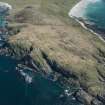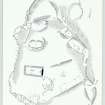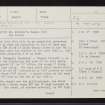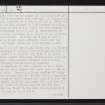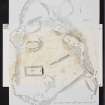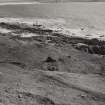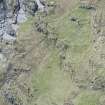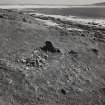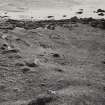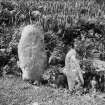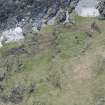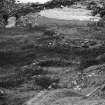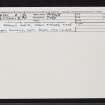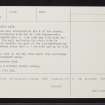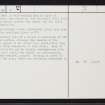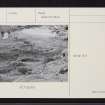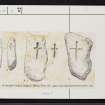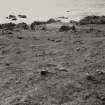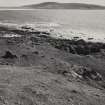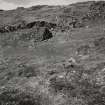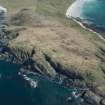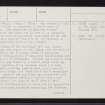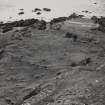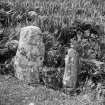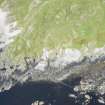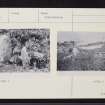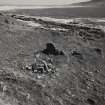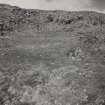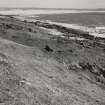Tiree, Ceann A' Mhara
Chapel (Medieval), Enclosure (Early Medieval), Monastery (Early Medieval)(Possible), Well (Medieval)
Site Name Tiree, Ceann A' Mhara
Classification Chapel (Medieval), Enclosure (Early Medieval), Monastery (Early Medieval)(Possible), Well (Medieval)
Alternative Name(s) St Patrick's; Temple; Teampull Phadruig; Temple Patrick; Balephuil Bay
Canmore ID 21477
Site Number NL94SW 2
NGR NL 9377 4013
Datum OSGB36 - NGR
Permalink http://canmore.org.uk/site/21477
- Council Argyll And Bute
- Parish Tiree
- Former Region Strathclyde
- Former District Argyll And Bute
- Former County Argyll
Field Visit (26 June 1972)
The chapel is as described, although there is no trace of an altar. The two pillar-stones lie loose inside the chapel, and the large stone visible under the shadow of a rock at the east gable, has only one cross on its visible side.
The revetted oval enclosure to the N of the chapel, measures internally 6.0m E-W by 2.6m transversely within a tumbled wall c. 1.5m wide and 0.2m high internally. The wall enclosing the whole site is sporadically visible for most of the circumference as a grass-covered stone wall c.1.5m wide and up to 0.5m high.
Within this wall on the NE, four small oval platforms possibly represent cells.
The well is a natural marshy spring.
Revised at 1/10,560.
Visited by OS (D W R) 26 June 1972.
Desk Based Assessment (1972)
NL94SW 2 9377 4013.
(NL 9376 4010) St. Patrick's Temple (NR) (In Ruins)
OS 6" map, Argyllshire, 2nd ed., (1900)
(NL 9377 4013) St Patrick's Chapel (NR) (remains of)
OS 1:10,000 map, (1976)
APs suggest that this site is an eremitical monastery comparable in size and situation to that of Sgor nam Ban-Naomha (NG20NW 2) which Thomas dates to the 7th c. The enclosing wall was visible in the late 18th century, the enclosed area measuring 1/3 of an acre.
The chapel 'Teampull Phadruig' - 'Temple Patrick' - is reduced to its foundation and part of the east gable, but it measured 26' by 11' within its rough, 3' thick, stone and lime walls. The east gable which stood about 7' externally and 5 1/2' internally in 1903 appears to have been only about 2'6" thick. A square altar at the east end stood 18" high at the end of the 18th century.
Close to the chapel are two pillar-stones, one about 26" high with a Latin cross 9 3/4" and 6" high incised on each side. The other, of coarser material, is 38" high with similar crosses measuring 13 3/4" by 11 1/2". A large stone of irregular shape and rough surface, its length varying from 42" to 36", lies under the shadow of a rock at the east gable. On one side is a cross 16 1/2" long with traces of a smaller, and, according to Reeves (W Reeves 1854), older cross, showing faintly below it. The reverse bears an 11" long cross.
A hillock about 10 yds north of the chapel has borne a separate oval-walled enclosure about 6 yds by 3 yds, containing traces of an erection measuring 4' square internally.
Just below the chapel is a small well near the shore, and in the rocks at about HWM are several curious round, deep holes, evidently natural, one of which, 2' wide and 4' deep, is known as St Patrick's Vat.
OSA 1794; W Reeves 1854; Name Book 1878; E Beveridge 1903; C Thomas 1971.
Information from OS.
Field Visit (1975)
St Patrick's Chapel, Ceann a' Mhara: The remains of this chapel stand within an enclosure on the W shore of Balephuil Bay. The enclosure follows the natural configuration of the site, and is thus of an irregular polygonal plan that is apparently open-ended to the SE; it measures 44m axially from N to S, and contains an area of approximately 0.14 ha (0.3 acres).
Fragmentary traces of the enclosure wall run intermittently along the crests of the ridges, and the wall is best preserved in the E sector, where it comprises massive outer facing-stones of dry-stone construction and measures over 1m in thickness. Towards the S end of this wall there is a gap formed by a narrow gully which may indicate the position of an entrance about 1m wide. Several scarped platforms are set within the broad ridge that forms the N and E boundaries of the site. Some of the platforms are associated with the slight turf-covered remains of rubble walls, and probably represent the sites of small huts of sub-rectangular or circular plan; at least one (B) appears to have been a nucleated structure comprising two chambers. The chapel stands near the SW corner of the enclosure and immediately NW of a prominent rock outcrop. A fragment of the E gable-wall survives to a height of 1.8m, while the remaining walls are now reduced to turf-covered footings. Against the centre of the E wall there are the remains of an altar-base measuring 1.1m by 0.9m, constructed of lime-mortared rubble, standing to a height of 0.5m above the original floor-level. Towards the W end of the N side-wall there is a gap which probably indicates the position of an entrance, about 0.6m in maximum width. Rather more than 7m N of the chapel there are the ruinous remains of a building of ovoid or sub-rectangular plan (E) which measures about 6m axially from E to W by about 2.7m transversely within dry-stone rubble walls 0.9m in average thickness. The exposed internal and external angles of the building are noticeably rounded. Indeterminate foundations of what appears to be a small hut or enclosure (F) also adjoin the rocky spur on the S boundary of the site. There is a loose scatter of stony debris along the scarped bank to the SE, while a squarish or L-shaped setting of small stones (G) some 9m E of the E wall of the chapel possibly indicates the position of a burial. A small sherd of grass-tempered pottery (not closely dateable) was found in the area immediately S of the chapel; it is now in the National Museum of Antiquities of Scotland [NMAS]. (Proc Soc Antiq Scot 1977)
'St Patrick's Vat', a well-defined swallow hole of natural formation, was observed, but the small well, said to have been situated between the chapel and the shore (E Beveridge 1903) was not identified.
The three cross-incised stones previously noted were also observed, in the positions given by OS field surveyor.
The site is probably that of a cashel or monastery of the Early Christian period, although the remains of the enclosure wall appear to be rather less substantial than those of other known monuments of this class. Some of the platform hut-sites may be roughly contemporary with the enclosure wall, while the chapel was subsequently added during the medieval period. Nothing is known of the history of the site, which was evidently dedicated to St Patrick.
Proc Soc Antiq Scot 1977; E Beveridge 1977; RCAHMS 1980, visited 1975.











































